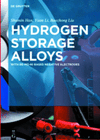issue contents
April 2019 issue

Cover illustration: Molecular surface of taxifolin nanoparticle, see R. P. Terekhov et al. [(2019). Acta Cryst. B75, 175-182].
scientific commentaries
Free 

A valuable addition to the toolkit for analysis of nucleic acid structures described by Gilski et al. [Acta Cryst. (2019), B75, 235–245] is discussed.
research papers
The electronic criterion for categorizing chalcogen or halogen bonds in complicated cases of S⋯I interactions in crystals is proposed. It is based on the dispositions of minima of electron density and electrostatic potential along the interatomic line.
Download citation


Download citation


A new (N2H4)WO3 compound has been obtained by mixing WO3 and aqueous hydrazine solution at room temperature for 24 h. The material crystallizes in the trigonal space group P3221 and is stable up to 220°C, greatly beyond the boiling point of N2H4 (114°C).
CCDC reference: 1846977
Evolutions of microstructure and crystal defects in the nanocrystalline WC–Co composite during room- and high-temperature deformations were studied using molecular dynamics simulations.
Download citation


Download citation


Unusually large plasticity of an organic crystal at liquid nitrogen temperature is described and rationalized using variable-temperature single-crystal X-ray diffraction data.
Download citation


Download citation


Variable-temperature neutron powder diffraction has been used to study the structure of ammonium iodate from 4.2 K to 290 K, in particular the hydrogen bonding between the ND4+ and IO3− ions. No phase transition is observed at 103 K, but at low temperatures the ammonium ion is firmly locked in place.
CCDC reference: 1907476
Download citation


Download citation


Anisotropic atomic displacement parameters of orthorhombic tridymite and tetragonal cristobalite can be determined accurately using the combined methods of powder XRD and pair distribution function analysis.
Download citation


Download citation


The new quaternary aluminide Li20Mg6Cu13Al42 was studied by the single-crystal method: cI162,  , a = 13.8451 (2), R[F2 > 2σ(F2)] = 0.023. The Li20Mg6Cu13Al42 structure can also be described as three-shell icosahedral clusters of [CuAl12@Li20Cu12@Al60] which can be enclosed inside a truncated octahedron of magnesium atoms in which all hexagonal faces are centered by lithium atoms. The electronic structure calculations confirm the concept of core–shell packing of clusters.
, a = 13.8451 (2), R[F2 > 2σ(F2)] = 0.023. The Li20Mg6Cu13Al42 structure can also be described as three-shell icosahedral clusters of [CuAl12@Li20Cu12@Al60] which can be enclosed inside a truncated octahedron of magnesium atoms in which all hexagonal faces are centered by lithium atoms. The electronic structure calculations confirm the concept of core–shell packing of clusters.
CCDC reference: 1889258
Download citation


Download citation


Microtubes of taxifolin were synthesized by crystal engineering. They were characterized using physicochemical, microscopic, spectral and computational methods of analysis.
Download citation


Download citation


A first-order phase transformation in tapentadol hydrochloride, taking place at ca 318 (1) K (on heating) and 300 (1) K (on cooling), is described and the changes in crystal structure relating the high-temperature and low-temperature forms are analyzed. The crystals present an ostensible thermosalient behaviour during the transformation, explainable through some abrupt unit-cell changes taking place.
Download citation


Download citation


An unusual cocrystal of salt and neutral molecule was formed from the equimolar solution of 6,7-dimethoxy-1,2,3,4-tetrahydroisoquinoline (heliamine) and bicyclo[2.2.1]hept-5-ene-endo-2,3-dicarboxylic acid due to peculiarities of crystal packing formation.
CCDC reference: 1576624
The indicator of quantum pressure focusing (IQPF) displays the inner-crystal regions where the electronic pressure is concentrated or depleted due to the quantum kinetic, exchange and correlation effects. It reveals the chemical bond features in crystals, using orbital-free formalism of the density functional theory in combination with experimental electron density.
Download citation


Download citation


This article describes novel strontium iodide–fructose-based metal–organic frameworks with nonlinear optical properties, with a high potential for theragnostic applications in cancer radiotherapy.
Download citation


Download citation


The crystal structures and solubilities of three nicotinic acid salts with (1R,2R)-1,2-diphenylethylenediamine are discussed and an analysis of synthon preference is provided.
The crystal structure solutions for Zr6Ta2O17, Hf6Nb2O17 and Hf6Ta2O17 have been solved using synchrotron X-ray and neutron powder diffraction. These structures have been shown to be isomorphous with each other and Zr6Nb2O17, leading to the classification of the A6B2O17 orthorhombic compound family with symmetry Ima2 (No. 46).
Open  access
access
 access
accessRevised geometrical parameters are proposed for the Watson–Crick pairs of nucleobases, for use as restraints in modeling and refinement of the structures of nucleic acids. Accurate values of these parameters were derived (and compared) from small-molecule Cambridge Structural Database structures, from super accurate ultrahigh-resolution nucleic acid structures in the Protein Data Bank, and from quantum mechanical calculations. The effect of base pairing on the molecular geometry of the nucleobases is also investigated.
Download citation


Download citation


The high-pressure and low-temperature behaviour of the GeSexTe1−x system was studied using in situ diffraction and DFT calculations. The high-pressure phase of GeTe-III was determined.
CCDC reference: 1881565
Download citation


Download citation


Crystals of La2Ti2O7 undergo successive phase transitions between the low-temperature monoclinic phase and the high-temperature orthorhombic phase with an intermediate incommensurately modulated phase at around 1000 K.
B-IncStrDB reference: 13652ELqsk9
CCDC references: 1895906; 1895907; 1895908; 1895909; 1895910; 1895911; 1895912; 1895913; 1895914; 1895915; 1895916; 1895917; 1895918; 1895919; 1895920; 1895921; 1895922; 1895923; 1895924; 1895925; 1895926; 1895927; 1895928; 1895929; 1895930; 1895931; 1895932; 1895933; 1895934; 1895935; 1895936; 1895937; 1895938; 1895939; 1895940; 1895941; 1895942; 1895943; 1895944; 1895945; 1895946; 1895947
Download citation


Download citation


A single-crystal X-ray diffraction and XANES investigation of the mineral petzite is reported.
CCDC reference: 1896511
The empirical relations between cubic spinel oxides with different compositions were investigated using data from 349 refined crystal structures. The results show that the spinel structure is able to tolerate many constituents and the structure distortion can be explained in terms of variation in ionic potential (= charge/size) at the cation sites.
book reviews
Free 



 journal menu
journal menu













































